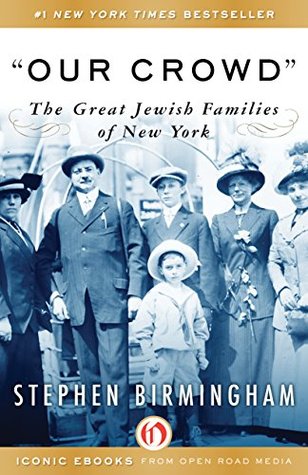Our Crowd: The Great Jewish Families of New York
Summary (from the publisher): They immigrated to America from Germany in the nineteenth century with names like Loeb, Sachs, Seligman, Lehman, Guggenheim, and Goldman. From tenements on the Lower East Side to Park Avenue mansions, this handful of Jewish families turned small businesses into imposing enterprises and amassed spectacular fortunes. But despite possessing breathtaking wealth that rivaled the Astors and Rockefellers, they were barred by the gentile establishment from the lofty realm of “the 400,” a register of New York’s most elite, because of their religion and humble backgrounds. In response, they created their own elite “100,” a privileged society as opulent and exclusive as the one that had refused them entry.
Our Crowd is the fascinating story of this rarefied society. Based on letters, documents, diary entries, and intimate personal remembrances of family lore by members of these most illustrious clans, it is an engrossing portrait of upper-class Jewish life over two centuries; a riveting story of the bankers, brokers, financiers, philanthropists, and business tycoons who started with nothing and turned their family names into American institutions.
Review: I received a copy of this book from NetGalley.
This work of non-fiction details the close knit group of wealthy Jewish families that settled in New York City in the nineteenth century. With names including "Lehman, Lewisohn, Schiff, Loeb, Warburg, Guggenheim, Seligman, Kahn, Straus, Goldman, and Sachs are nationally, and in most cases internationally, known. They stand for banking and industrial efficiency, government service, philanthropy and vast patronage of the arts, science, and education." With the exception of the Guggenheims - "who came from German-speaking Switzerland - all these families trace their origins to Germany." They have have referred to themselves as "the One Hundred," the "Jewish Grand Dukes," but most often as "our crowd."
The majority made their fortunes as merchants or bankers and married within the tight circle of families in order to maintain the wealth and exclusivity of their group. For example, "for nearly fifty years after Goldman, Sachs was founded, all partners were members of the intermarried Goldman and Sachs families. Meanwhile, for nearly seventy-five years, or until 1924, all partners in the Lehman firm carried the name Lehman. The majority were Jewish in name only, despite originating from German families who followed the religious and dietary laws scrupulously. Upon arrival in America, this proved difficult to maintain. Their rise from poor immigrants to millionaires was impressive and founded on hard work and a willingness to fill holes in current American services. For examples, the Seligman's selling theory was "Sell anything that can be bought cheaply, sold quickly at a little profit, small enough to place inside a pack and light enough to carry." Initially, the Seligman brothers traveled on foot, carrying packs that weighed from one to two hundred pounds.
Soon, these families transformed themselves into an elite who lived in "palaces of brownstone and marble" along Fifth Avenue. The Belmonts built the "first private house in the city to have its own ballroom." And their families continued to swell. The original eleven Seligman siblings that immigrated to New York had grown to include 104, including husbands, wives, and children by the end of the first world war. However, these families were not infallible from making poor business choices. For instance, Joseph Seligman turned down the opportunity to purchase more than three square miles of Manhattan for a mere $450,000. Had he purchased it, "the Seligmans today would easily be the richest family in the world." On the other hand, these families should be recognized for their significant philanthropic world, which was often conducted anonymously because they considered it their civic obligation.
My biggest frustration with this book is that the topic was far too broad to cover well. Both the number of families, the size of the families themselves, and the time period covered within this book are vast. This led to feeling as if I was reading selected anecdotes from the families rather than comprehensive histories of each. Additionally, it was difficult to keep each of the families straight. My other main complaint was that extensive time was spent detailing the business lives of these families, in which I had much less interest than their social and cultural lives. I found anecdotes about their odd quirks, parenting choices, and social intrigue far more interesting. Instead, I was mired down in banking, speculating, and railroad details. Furthermore, I found the first half of this book far more interesting than the second. The first deals with the new immigrants building their fortunes and establishing connections in their new country while the second half too heavily bogged down in business deals and political intrigues.
Over time, these once great families and their related businesses and fortunes have mostly declined. The Seligman business has gradually shrunk from "a great international banking house with offices in New York, San Francisco, New Orleans, Paris, and London to what it is today - a small, prestigious investment house with but a single office in New York."
Stars: 4



Comments
Post a Comment